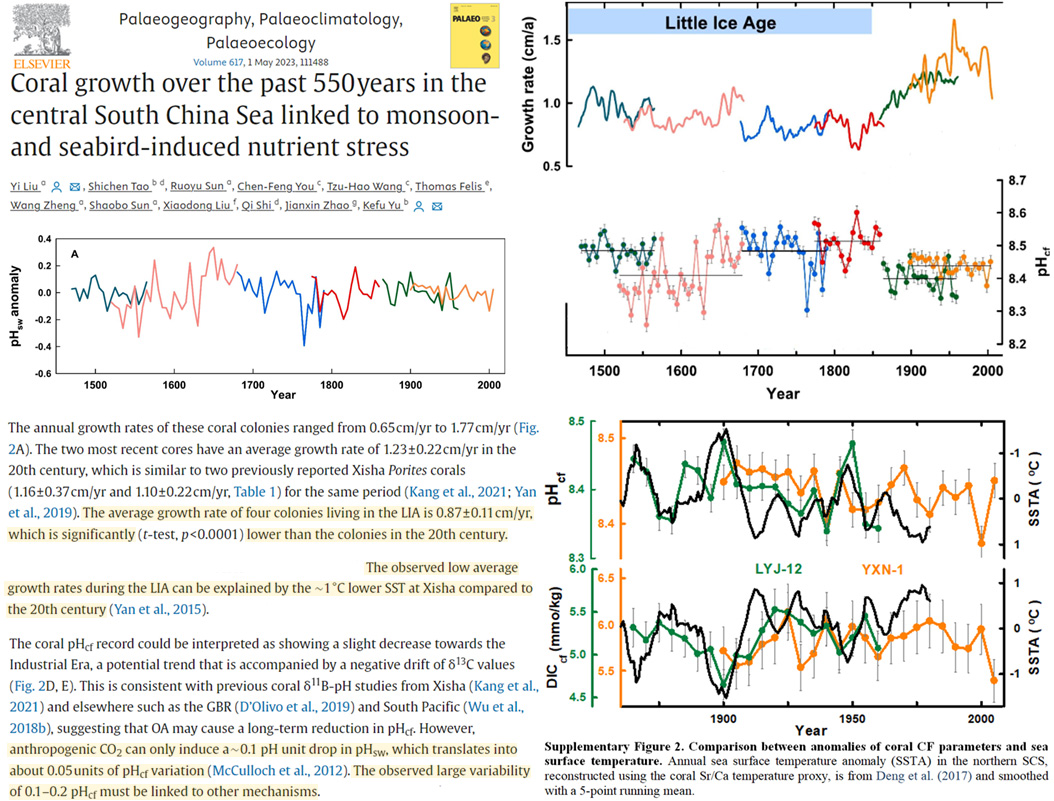Warmer sea surface temperatures are associated with coral growth, not decline.
According to a new study, coral growth was slow during the ~1°C colder Little Ice Age (LIA), but grew rapidly as sea surface temperatures (SSTs) warmed after 1850. Warmth is associated with coral growth, whereas colder SSTs are linked to growth rate decline.
“The average growth rate of four colonies living in the LIA is 0.87 ± 0.11 cm/yr, which is significantly (t-test, p < 0.0001) lower than the colonies in the 20th century [1.23 ± 0.22 cm/yr].”
“The observed low average growth rates during the LIA can be explained by the ~1°C lower temperature.”
Ocean pH levels were as low or lower (more “acidified”) than recent decades during the LIA (e.g., 1500s to 1700s CE), suggesting that the atmospheric CO2 levels are not an ocean pH variability determinant. In fact, the authors point out that anthropogenic CO2 can only ever affect pH variability by 0.05 of a unit over centuries, whereas natural variations in pH units can reach 0.1 to 0.3 within a decade or less.

Image Source: Liu et al., 2023
Another new study (Gischler et al., 2023) also indicates that falling temperatures and declining sea level rise rates in the last few millennia after the warmer early- to mid-Holocene is “responsible for reef decline” in Beliz and south Florida.
“A decline in the rate of sea-level rise, as observed after 6 ka BP, has diminished accommodation space and, hence, reef accretion. Rate of rise in Holocene sea level and reef accretion rate indeed exhibit a positive correlation (Fig. 3B). Likewise, a mid-to-late Holocene temperature fall has been suggested to be responsible for reef decline in Beliz, as well as south Florida.”
“Coral sclerochronology and vegetation data from offshore Belize suggest also that warm and wet conditions during early Holocene times were followed by cooler and drier conditions in the mid-late Holocene. The results of the present study suggest that there are gaps in the Holocene A. palmata record, and, that A. cervicornis was twice as abundant during the early as compared to the mid and late Holocene (13.1 ± 1.7% vs. 6.7 ± 1.4% and 6.3 ± 1.7%, respectively), suggesting a deterioration in the environmental conditions for reef development over time.”





[…] Read more at No Tricks Zone […]
[…] 2 More New Studies Undermine Alarmist Claims That Corals Are Harmed By Warming […]
Great one, thanks
Here is a companion piece:
Coral Reef Recovery Disappoints Climate Alarmists
Worldwide recovery blunts fearmongering, real threats revealed
https://tucoschild.substack.com/p/coral-reef-recovery-disappoints-climate